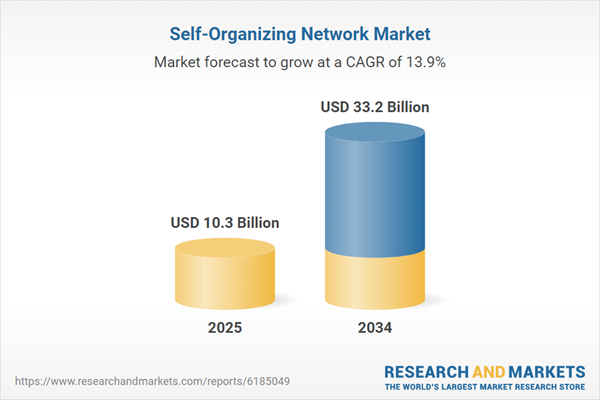The Self-Organizing Network (SON) market is gaining prominence as telecom operators seek smarter, more efficient ways to manage increasingly complex mobile networks. SON technology enables automated planning, configuration, optimization, and healing of mobile networks, reducing manual intervention and operational costs while improving network performance and user experience. With the rollout of 5G and densification of small cells, SON has become an essential tool for handling the dynamic nature of heterogeneous networks. It supports enhanced mobility, dynamic spectrum allocation, and real-time traffic management. By leveraging machine learning and AI, SON systems can adapt in real time to fluctuations in user demand, network failures, and environmental conditions. The technology is particularly beneficial in enhancing Quality of Service (QoS), minimizing dropped calls, and improving coverage. As the telecom industry accelerates its transition toward fully automated, self-healing networks, the SON market is expected to expand rapidly across developed and emerging economies.
The SON market witnessed significant strides in commercial deployment and technological refinement, driven by rapid 5G adoption worldwide. Major telecom operators implemented centralized and distributed SON models to support real-time network optimization and reduce latency. AI-based SON platforms emerged as a differentiator, enabling predictive analytics for capacity planning and fault management. Vendors introduced SON-as-a-service offerings, allowing smaller network operators to integrate automation without heavy capital expenditure. Open RAN (Radio Access Network) architecture adoption created new opportunities for SON integration, enabling interoperability between multi-vendor environments. Europe and North America led the charge with national 5G coverage projects, leveraging SON to streamline deployment and ensure consistent performance. In Asia-Pacific, countries like South Korea, Japan, and China expanded small cell networks in urban centers with SON technologies to manage congestion and ensure coverage. The year also saw increased R&D investment in next-gen SON platforms that combine big data analytics and cloud-native architectures.
The SON market is poised for deeper integration with AI-driven orchestration platforms and end-to-end network automation strategies. As telecom networks evolve into intelligent ecosystems, SON will play a critical role in enabling zero-touch operations, adaptive slicing, and energy-efficient network management. The expansion of private 5G networks for enterprises and industrial IoT deployments will create new demand for scalable and secure SON solutions. Vendors will focus on developing SON platforms that are compatible with hybrid cloud infrastructures, offering flexibility for multi-operator deployments. Emerging markets in Latin America, Africa, and Southeast Asia are expected to adopt SON to optimize limited resources and improve connectivity in underserved regions. As edge computing and ultra-reliable low latency communications (URLLC) mature, SON systems will be instrumental in dynamically managing distributed nodes and ensuring SLA compliance. Regulatory support for spectrum efficiency and quality benchmarks will further incentivize the adoption of self-organizing capabilities across the telecom landscape.
Key Insights: Self-Organizing Network Market
- Integration of AI and machine learning in SON platforms is enhancing predictive maintenance, automated troubleshooting, and dynamic resource allocation across 4G and 5G networks.
- Open RAN deployment is encouraging the development of vendor-agnostic SON solutions, enabling operators to build flexible, multi-vendor network environments without compromising on automation efficiency.
- Cloud-native SON architectures are gaining traction, offering scalability, faster deployment, and easier integration with orchestration platforms for both public and private networks.
- Rise in small cell deployments for 5G densification is boosting the need for distributed SON systems that can manage numerous low-power nodes in urban and indoor environments.
- SON-as-a-Service models are emerging as cost-effective solutions for regional operators and enterprises, reducing the complexity and capital investment traditionally associated with network automation.
- Rapid global expansion of 5G networks is increasing the demand for automated network management tools that can handle the complexity and scale of next-generation connectivity.
- Need to reduce operational expenditures and improve efficiency is pushing telecom operators to adopt SON to automate repetitive tasks and streamline network optimization processes.
- Growing adoption of multi-vendor network ecosystems is creating a demand for interoperable SON platforms that ensure seamless coordination across diverse infrastructure.
- Increasing mobile data traffic and user expectations for high-quality service are driving investment in SON to maintain consistent network performance and real-time responsiveness.
- Integration complexities with legacy systems and lack of standardization across SON implementations pose significant challenges, often slowing deployment and increasing the burden on network planning teams.
Self-Organizing Network Market Segmentation
By Offering
- Software
- Service
By Network
- Radio Access Network (RAN)
- Wi-Fi
- Core Network
- Backhaul
By Deployment
- Public Cloud
- Private Cloud
- Hybrid Cloud
By Application
- Network Security and Authentication
- Wireless Application Protocol (WAP)
- Intermachine Communication
- Global Positioning System
- Gaming
- Other Applications
By End-User
- Telecommunications
- Manufacturing
- Retail
- Healthcare
- Banking
- Financial Services
- and Insurance (BFSI)
Key Companies Analysed
- Verizon Communications Inc.
- Huawei Technologies Co. Ltd.
- Siemens AG
- Cisco Systems Inc.
- Qualcomm Incorporated
- Telefonaktiebolaget LM Ericsson
- Nokia Corporation
- NEC Corporation
- ZTE Corporation
- Corning Incorporated
- Commscope
- Amdocs Inc.
- Rohde & Schwarz
- Viavi Solutions Inc.
- Comarch SA
- Ascom Holding AG
- Infovista
- Casa Systems
- Teoco Corporation
- RadiSys Corporation
- Airspan Networks Inc.
- Cambridge Communication Systems Ltd. (CCS)
- Blinq Networks
- Hughes Systique Corporation
- RED Technologies
- P.I. Works
- Airhop Communications Inc.
Self-Organizing Network Market Analytics
The report employs rigorous tools, including Porter’s Five Forces, value chain mapping, and scenario-based modeling, to assess supply-demand dynamics. Cross-sector influences from parent, derived, and substitute markets are evaluated to identify risks and opportunities. Trade and pricing analytics provide an up-to-date view of international flows, including leading exporters, importers, and regional price trends.
Macroeconomic indicators, policy frameworks such as carbon pricing and energy security strategies, and evolving consumer behavior are considered in forecasting scenarios. Recent deal flows, partnerships, and technology innovations are incorporated to assess their impact on future market performance.Self-Organizing Network Market Competitive Intelligence
The competitive landscape is mapped through proprietary frameworks, profiling leading companies with details on business models, product portfolios, financial performance, and strategic initiatives. Key developments such as mergers & acquisitions, technology collaborations, investment inflows, and regional expansions are analyzed for their competitive impact. The report also identifies emerging players and innovative startups contributing to market disruption.
Regional insights highlight the most promising investment destinations, regulatory landscapes, and evolving partnerships across energy and industrial corridors.Countries Covered
- North America - Self-Organizing Network market data and outlook to 2034
- United States
- Canada
- Mexico
- Europe - Self-Organizing Network market data and outlook to 2034
- Germany
- United Kingdom
- France
- Italy
- Spain
- BeNeLux
- Russia
- Sweden
- Asia-Pacific - Self-Organizing Network market data and outlook to 2034
- China
- Japan
- India
- South Korea
- Australia
- Indonesia
- Malaysia
- Vietnam
- Middle East and Africa - Self-Organizing Network market data and outlook to 2034
- Saudi Arabia
- South Africa
- Iran
- UAE
- Egypt
- South and Central America - Self-Organizing Network market data and outlook to 2034
- Brazil
- Argentina
- Chile
- Peru
Research Methodology
This study combines primary inputs from industry experts across the Self-Organizing Network value chain with secondary data from associations, government publications, trade databases, and company disclosures. Proprietary modeling techniques, including data triangulation, statistical correlation, and scenario planning, are applied to deliver reliable market sizing and forecasting.Key Questions Addressed
- What is the current and forecast market size of the Self-Organizing Network industry at global, regional, and country levels?
- Which types, applications, and technologies present the highest growth potential?
- How are supply chains adapting to geopolitical and economic shocks?
- What role do policy frameworks, trade flows, and sustainability targets play in shaping demand?
- Who are the leading players, and how are their strategies evolving in the face of global uncertainty?
- Which regional “hotspots” and customer segments will outpace the market, and what go-to-market and partnership models best support entry and expansion?
- Where are the most investable opportunities - across technology roadmaps, sustainability-linked innovation, and M&A - and what is the best segment to invest over the next 3-5 years?
Your Key Takeaways from the Self-Organizing Network Market Report
- Global Self-Organizing Network market size and growth projections (CAGR), 2024-2034
- Impact of Russia-Ukraine, Israel-Palestine, and Hamas conflicts on Self-Organizing Network trade, costs, and supply chains
- Self-Organizing Network market size, share, and outlook across 5 regions and 27 countries, 2023-2034
- Self-Organizing Network market size, CAGR, and market share of key products, applications, and end-user verticals, 2023-2034
- Short- and long-term Self-Organizing Network market trends, drivers, restraints, and opportunities
- Porter’s Five Forces analysis, technological developments, and Self-Organizing Network supply chain analysis
- Self-Organizing Network trade analysis, Self-Organizing Network market price analysis, and Self-Organizing Network supply/demand dynamics
- Profiles of 5 leading companies - overview, key strategies, financials, and products
- Latest Self-Organizing Network market news and developments
Additional Support
With the purchase of this report, you will receive:- An updated PDF report and an MS Excel data workbook containing all market tables and figures for easy analysis.
- 7-day post-sale analyst support for clarifications and in-scope supplementary data, ensuring the deliverable aligns precisely with your requirements.
- Complimentary report update to incorporate the latest available data and the impact of recent market developments.
This product will be delivered within 1-3 business days.
Table of Contents
Companies Mentioned
- Verizon Communications Inc.
- Huawei Technologies Co. Ltd.
- Siemens AG
- Cisco Systems Inc.
- Qualcomm Incorporated
- Telefonaktiebolaget LM Ericsson
- Nokia Corporation
- NEC Corporation
- ZTE Corporation
- Corning Incorporated
- Commscope
- Amdocs Inc.
- Rohde & Schwarz
- Viavi Solutions Inc.
- Comarch SA
- Ascom Holding AG
- Infovista
- Casa Systems
- Teoco Corporation
- RadiSys Corporation
- Airspan Networks Inc.
- Cambridge Communication Systems Ltd. (CCS)
- Blinq Networks
- Hughes Systique Corporation
- RED Technologies
- P.I. Works
- Airhop Communications Inc.
Table Information
| Report Attribute | Details |
|---|---|
| No. of Pages | 160 |
| Published | October 2025 |
| Forecast Period | 2025 - 2034 |
| Estimated Market Value ( USD | $ 10.3 Billion |
| Forecasted Market Value ( USD | $ 33.2 Billion |
| Compound Annual Growth Rate | 13.8% |
| Regions Covered | Global |
| No. of Companies Mentioned | 27 |









